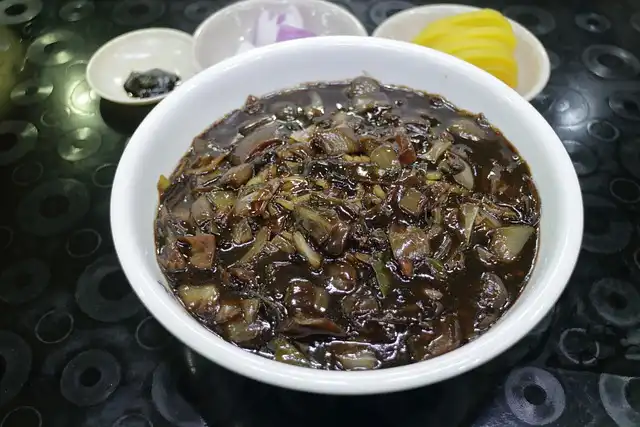
Once firmly into the main courses, Kim and the crew feature a steamed sea perch with scarlet prawn, dry-aged dairy cow with roasted sesame, creamy perilla noodles topped with shaved winter truffles, and charcoal-grilled lobster tail with doenjang sauce and raspberry powder.
Once located, Kim provides a short overview and instantly offers the very first of 3 treats: the alien-like orb of cod milt (likewise called shirako) tinted with a pale red-orange kimchi sauce atop a tiny sphere of rice and a cyndrical tube of crispy bugak algae. Kim likes gimbap and wanted to invoke his favorite Korean snack: “While cod milt is typical in haemul-tang [seafood stew], I intended to capture the harmonious flavors of rice and banchan, where you make your very own combination with every bite,” he states. He would serve the cod milt gimbap via the year, yet the included ingredient is just available in the wintertime, which indicates he’ll switch it up in spring. The unforeseen crisp of the bugak and the pleasant, almost luscious milt makes the bite a very memorable begin.
Ki is open Wednesday to Sunday, with one seating at 6:30 p.m. Reservations are offered on Tock, with tickets valued at $285 each. A glass of wine pairing sets you back $190 with a complete a glass of wine and Korean spirits food selection.
Matthew Kang
is the Lead Editor of Eater LA. He has covered dining, restaurants, food culture, and night life in Los Angeles given that 2008. He’s the host of K-Town, a YouTube collection covering Korean food in America, and has been featured in Netflix’s Street Food program.
The chef shared his mental health and wellness trip in the results of the closure of Kinn, a struggle that he says therapy helped to ease. Offering the lamb here represents a sort of victory, a recommendation of previous difficulties that have actually been overcome or are still in the cycle of progression. The meal completed with omija, a Korean berry so complex the name refers to its five distinctive flavors of wonderful, sour, bitter, salty, and poignant, ready as shaved ice with strawberry lemon, and cranberry.
Once securely into the main dishes, Kim and the crew function a steamed sea perch with scarlet prawn, dry-aged dairy cow with baked sesame, velvety perilla noodles covered with shaved winter season truffles, and charcoal-grilled lobster tail with doenjang sauce and raspberry powder. The mouthwatering programs finish in a lamb saddle carved on the counter and offered with smoked tomato-stuffed morels. “Morels are generally served in spring, and the ‘next season’ approach is like Japanese kaiseki ‘hashiri,’ which suggests accepting what’s coming,” states Kim. Lamb isn’t as popular as beef, poultry, or pork in South Korea, it’s growing in popularity. Kim says he fell in love with lamb when he came in to the U.S., touchdown in the town of Aurora near Denver. “I had a hard time to fit in and it was a huge change in my life. I was an upset young adult and couldn’t appreciate myself, yet lamb was something I really liked in Colorado,” claims Kim.
Ki, named after its chef Ki Kim, offers a multi-course counter tasting food selection for $285 per individual that weaves through a deeply personal story while discovering numerous elements of Korean components, food preparation strategies, and flavors. As soon as positioned, Kim gives a quick introduction and promptly offers the first of three treats: the alien-like orb of cod milt (likewise called shirako) tinted with a pale red-orange kimchi sauce atop a small round of rice and a cylinder of crunchy bugak seaweed. “Morels are typically offered in spring, and the ‘following period’ technique is like Japanese kaiseki ‘hashiri,’ which implies embracing what’s coming,” says Kim. Kim claims he dropped in love with lamb when he came in to the U.S., touchdown in the community of Aurora near Denver. Kim and the kitchen group are currently believing about what they plan to offer in the spring– not web content to maintain the dishes stagnant.
Delicate steed mackerel slices wrapped around aged baek-kimchi, or kimchi without any gochugaru, and perilla leaf are one more snack. Kim’s now trademark crunchy octopus with an abundant octopus head sauce comes as the third in the schedule. Kim’s especially proud of the barbequed lettuce (sangchu) ice cream, which he conceived by charring, dehydrating, and afterwards instilling an ice cream base. The chungju cream, which uses the unfiltered rice beverage, includes a slightly sweet contrast to the natural quenelle of lettuce ice cream. Here he offers a strong glob of Astrea relish, a brand he likes because it’s sourced from older sturgeons, which has less “pop” in the structure but a richer umami finish. “It took me a number of years to recognize that eggs is actually excellent,” stated Kim. “When I had a caviar dish offered with asparagus gelato at Aska in New York, it was a surprising point, and caviar with ice cream got embeded my head,” he says.
After the rigamarole of finding the area (simply look into the host mean Kaneyoshi and Bar Sawa), find a long, wide counter that seats approximately 12 restaurants, though a lot of evenings will only suit 8. The dominating themes of Kim’s menu are “convenience and style,” words he utilized often in a current conversation with Eater over the phone. Part of that starts with the restaurant’s only offered eating time of 6:30 p.m. (samplings that try to accommodate 2 turns typically end up with a too-early 5 p.m. or 5:30 p.m. reservation and afterwards a too-late 8:30 p.m. or 9 p.m. 2nd service, he says).
Probably the most interesting new modern-day Korean dining establishment in Los Angeles opened on January 16 in the basement of a Little Tokyo office complex. Ki, called after its cook Ki Kim, serves a multi-course counter tasting menu for $285 per person that weaves via a deeply personal narrative while checking out numerous facets of Korean components, cooking methods, and flavors. Already, the recipes evince a maturity one might anticipate from a decades-long operation, with Kim’s co-chefs Ryan Brown and Shingo Kato bringing their own culinary firepower to the intimate eating experience.
Kim arrived in Los Angeles after an extensive fine eating trip: He functioned most lately as the chef de cuisine at Meteora, a setting he held while it earned its very first Michelin star. Before that, Kim ran his very own decently valued tasting food selection dining establishment Kinn in Koreatown, drawing appreciation from Los Angeles Times critic Costs Addison and otherpublications. Addison, particularly, suggested the food at Kinn might be part of the evolving future of great eating in Los Angeles. That prediction may happen at Ki, which joins late 2023’s well known return of Baroo in the Arts District and the Michelin-recognized Hibi in Koreatown, which offers its very own Korean and Japanese-inflected food. Ki seems to aim to cook at a level with various other very regarded counters like Chef’s Table at Brooklyn Fare, Atomix, and Catbird Seat.
Kim and the kitchen team are currently thinking of what they intend to offer in the springtime– not content to maintain the recipes stationary. Ki, the restaurant, represents a ruthless pursuit, a standard-setting supper that can improve Los Angeles’s assumption of the possibilities of Oriental food. Whether it signs up with the discussion begun by Kim’s former employer Jungsik and Atomix in New York City City, Baroo here in LA, Jeong in Chicago, and Ssal in San Francisco, continues to be to be seen, yet great dining followers should definitely be excited.
Throughout a lot of the supper service, the chefs zig-zag around, cleaning plates of smoked lobster slices over doenjang butter sauce with raspberry powder or slicing a rosemary-roasted Colorado lamb saddle right into bite-sized items. Against the backdrop of a multitude of modernist tasting food selection dining establishments that have actually opened in current weeks, including Santa Monica’s Seline and West Hollywood’s Somni, Ki is composing its own fascinating chapter with the unique shades of Oriental cuisine.
1 ambitious Los Angeles2 Kim
3 Lead Editor
4 Los Angeles Times
5 Matthew Kang
« Brands Report 2025: American whiskey – Drinks International – The global choice for drinks buyersNYC mainstay Bryant Park Grill loses bid to renew lease — for fancier restaurant from Jean-Georges Vongerichten »
